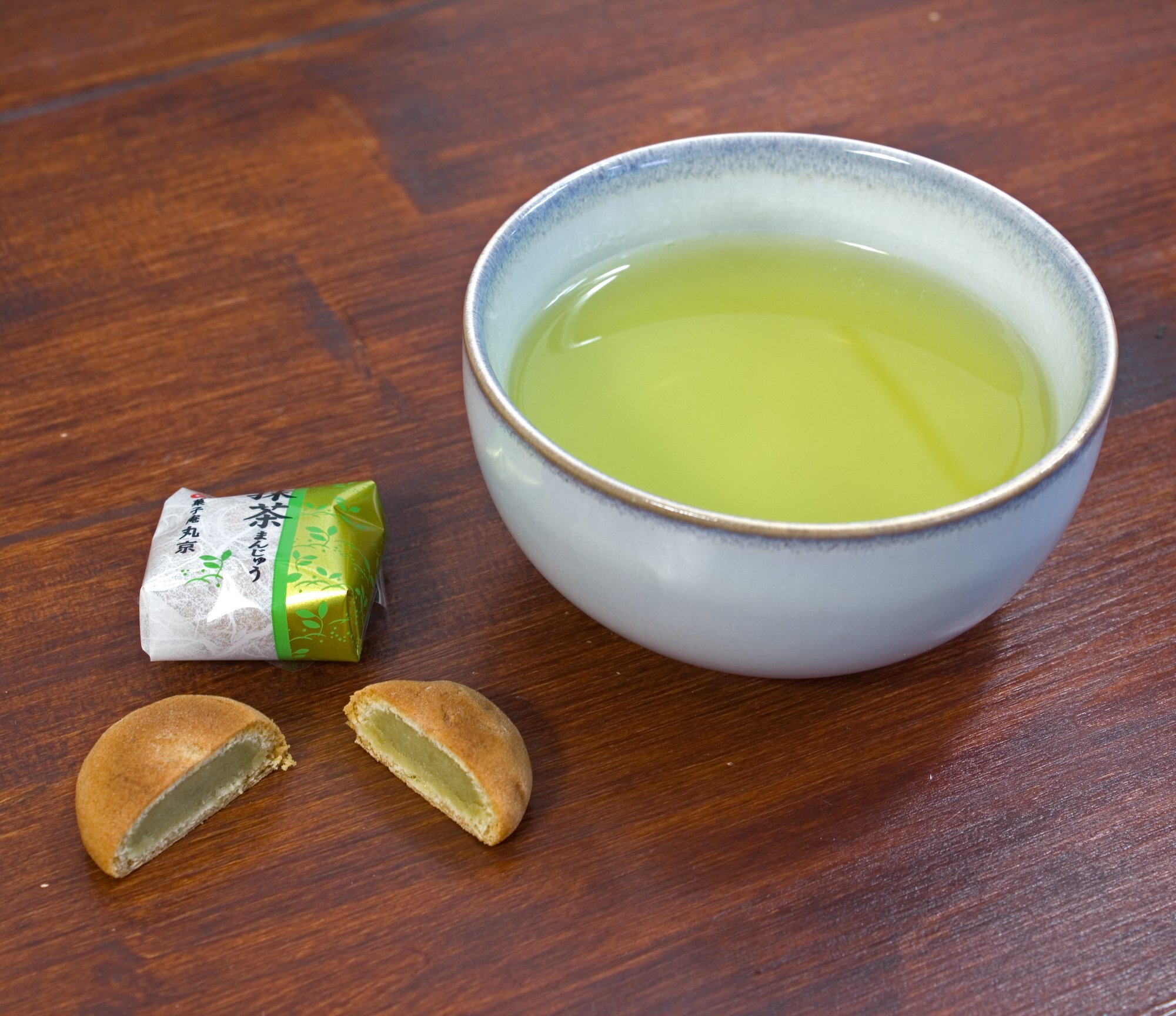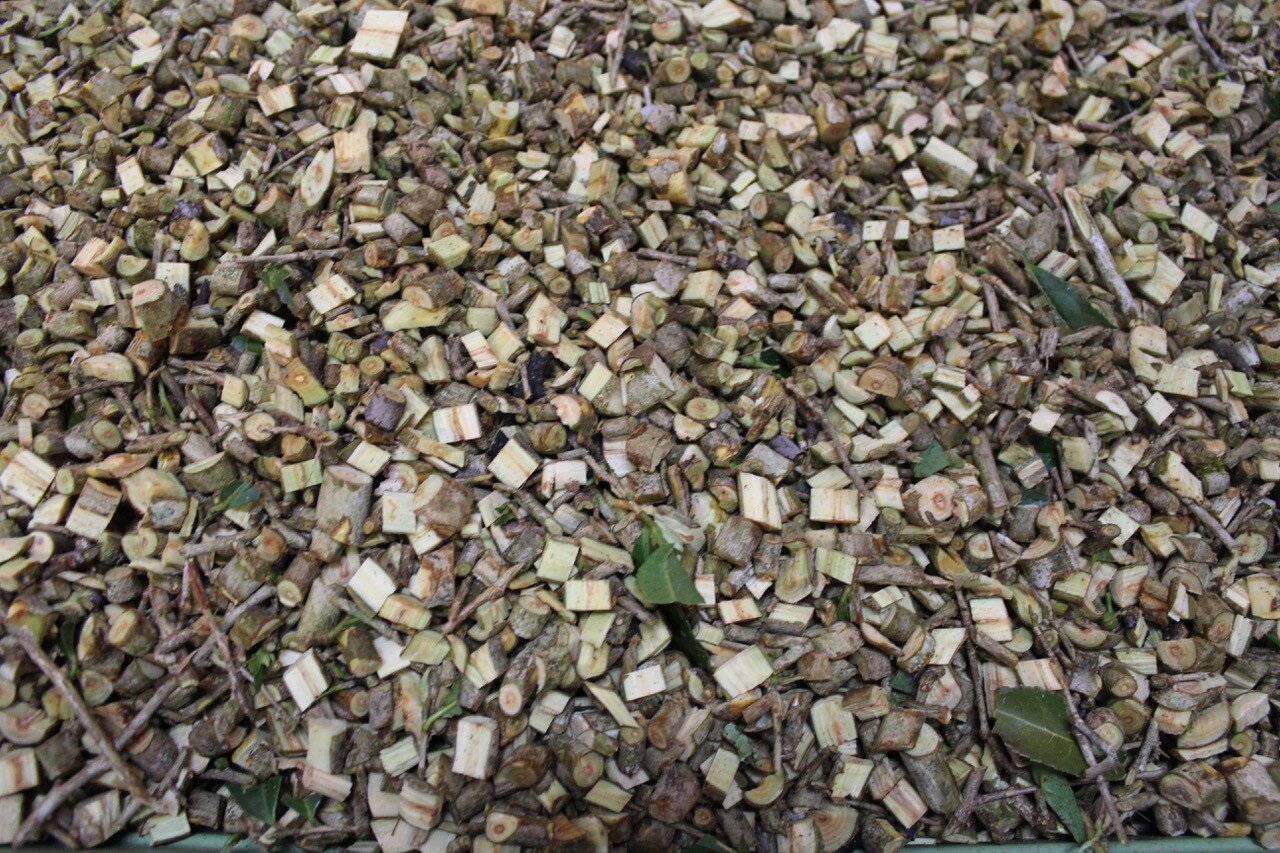Grüner Tee aus Japan - welche Sorten gibt es?
Sencha hat eine typischerweise leuchtend gelb-grüne Aufgussfarbe und schmeckt fruchtig-frisch bis leicht grasig.
SENCHA 煎茶
Sencha ist die am meisten produzierte Sorte in Japan und der wohl bekannteste japanische Grüntee. Es ist grüner Tee, der unbeschattet, also in vollem Sonnenschein, heranwächst und nach der Ernte sofort gedämpft und gerollt wird. Geschmacklich ist er kräftig und kann grasige und fruchtige bis hin zu gemüsig-würzige Noten aufweisen.
Innerhalb der Sorte Sencha gibt es viele Variationen: Kukicha und Fukamushi sind die häufigsten Sencha-Variationen, die sich nochmals in der Verarbeitung unterscheiden:
Kukicha besteht aus den Stängeln von Sencha, die bei der Sortierung aus dem grünen Tee entfernt werden. Statt diese wegzuschmeißen, werden sie als eigener Tee verkauft. Der Tee hat zwar weniger Umami und Aroma, als ein klassicher Sencha, ist dafür aber auch erfrischend leicht und enthält kaum Koffein.
Eine weitere Variation ist Fukamushicha. Sencha wird nicht nur bedampft, um die Oxidation zu stoppen, sondern auch um verschiedene Geschmacksrichtigungen zu erzeugen. Auch kann man mit der Länge der Bedampfung unerwünschte Eigenschaften einer bestimmten Ernte positiv beeinflussen. Im Gegensatz zur “normalen” Bedampfung (Asamushi: 20-40s) bzw. mittellangen Bedampfung (Chumushi: 40-60s) wird der Sencha als Fukamushi sehr lang, bis zu 120 Sekunden lang, bedampft. Die Blätter brechen dadurch in kleinere Teile. Statt der üblichen langen nadelförmigen Teeblätter erscheint der Fukamushicha brüchig und leicht pulverig. Der Tee bekommt im Aufguss eine sehr grüne Farbe, ist trüber und süßlicher. Diese Bedampfung gibt es übrigens nicht nur bei Sencha, sondern kann auch bei einem Gyokuro angewendet werden.
KABUSECHA かぶせ茶
Kabusecha hat eine tiefgrüne Farbe im Aufguss und schmeckt aromatisch süßlich.
Kabusecha ist eine besondere Sencha-Variation, die mittlerweile als eigene Sorte gehandelt wird. Hier werden die Teeblätter bis zu 10 Tage vor der Ernte mit Netzen beschattet. Die Netze sind halbdurchlässig - daher wird der Tee auch Halbschatten-Tee genannt. Es entsteht ein intensiv-aromatischer und tiefgrüner Tee, der so gut wie keine Bitternoten aufweist. Der Tee ist reich an Umami und besitzt eine intensive Süsse. Im Gegensatz zu “normalem” Sencha enthält Kabusecha mehr Koffein.
GYOKURO 玉露
Iwakura Teefarm bei der Grüntee-Ernte
Gyokuro gilt als der hochwertigste grüne Tee in Japan. Ähnlich wie Kabusecha wird Gyokuro auch vor der Ernte beschattet. Diese Beschattung kann jedoch bis zu 4 Wochen erfolgen. Ein extrem milder grüner Tee mit gleichzeitig komplexen Aromen entsteht, der besondere Vorsicht bei der Zubereitung bzgl. der Temperatur und Ziehdauer erfordert. Bei der richtigen Zubereitung entfaltet sich ein sehr starkes Umami mit vielen Geschmacks- und Geruchsnuancen, die sich von Aufguss zu Aufguss verändern.
Eine beliebte weil günstige Variante von Gyokuro ist Karigane. Ähnlich wie Kukicha werden hier nur die aussortierten Stängel und gebrochenen Blätter genommen. So entsteht quasi eine hochwertige Kukicha-Version.
BANCHA 番茶
Bancha ist eine qualitativ minderwertigere Version von Sencha. Üblicherweise werden für Bancha die Blätter aus der zweiten bzw. dritten Ernte (Sommer/Herbst) verwendet, die tiefer am Teestrauch wachsen. Diese sind etwas härter, größer, weniger intensiv grün & haben am längsten Sonnenschein abbekommen. Bancha hat dadurch nicht den typisch frisch-grasigen Geschmack, ist weniger fruchtig und je nach Qualität ausgewogen-mild bis kräftig-edelbitter. Er enthält einen hohen Anteil an Catechinen, die den Tee zwar recht herb machen, aber auch sehr positiv auf den Körper wirken. Außerdem enthält Bancha viele gesunde Gerbstoffe und nur wenig Koffein, was ihn zu einem sehr bekömmlichen grünen Tee macht. Häufig wird Bancha auch mit geröstetem Reis gemixt als Genmaicha (玄米茶) angeboten. Ein sehr süffiger grüner Tee mit feinen Röstaromen.
HOUJICHA ほうじ茶
Houjicha kann auch aus ganzen ungerollten Blättern hergestellt werden.
Hojicha ist ein grüner Tee, der geröstet wird. Hierzu kann Sencha, Bancha oder auch Kukicha verwendet werden. Man kann den Tee gut an seiner rotbraunen Farbe erkennen. Das frische und fruchtig-grasige Aroma des grünen Tees wird dadurch stark verringert. Stattdessen schmeckt der Aufguss nussig-karamellig und ist kaum herb.
Ganze Stämme von Teesträuchern werden für den Sannenbancha verwendet.
Eine besondere Variante des Hojicha ist der Sannenbancha (Drei-Jahr-Bancha). Teeblattstängel bis hin zu ganzen Teesträuchern werden vom Teebaum geschnitten und für 3 Jahre zur Reifung gelagert. Erst dann werden die Stängel und Äste zerkleinert und geröstet. Sannenbancha hat ein besonders nussiges bzw. fast schon erdiges Aroma und gilt als äußerst gesund. Bei der Zubereitung muss je nach Dicke der Stängel/Äste der Tee sehr lange gekocht werden. Diese Art der Zubereitung stammt aus der Zeit, wo japanische Häuser noch eine Feuerstelle in der Mitte hatten. Der Sannenbancha wurde in einen Kessel gefüllt und auf der Feuerstelle einfach den Tag köcheln gelassen und bei Bedarf etwas eingeschenkt.
MATCHA 抹茶
Neben Sencha ist Matcha die wohl bekannteste Grüntee-Sorte aus Japan. Genauso wie Gyokuro wird Matcha 3-4 Wochen vor der Ernte mit Planen abgedeckt. So wird er besonders intensiv grün, süßlich und aromatisch. Nach der Ernte & Weiterverarbeitung wird er in Granitmühlen zu feinstem Pulver gemahlen. Wichtig ist hierbei, dass nicht das komplette Teeblatt verarbeitet wird: Stengel und Blattgerippe werden von dem Blatt getrennt. Nur so entsteht ein authentischer Matcha. Zur Zubereitung wird mit einem Bambus-Besen das Matcha Pulver in wenig Wasser aufgeschlagen. Mehr zur Zubereitung von Matcha erfahrt ihr in unser Rubrik How To Matcha.
Eine hohe Qualität erkennt man an der leuchtend grünen Farbe des Matcha Pulvers.
Das fein gemahlene Matcha Pulver wird mit Wasser zu einem schönen Schaum aufgeschlagen.
Und was ist mit SHINCHA? 新茶
Shincha ist keine eigene Sorte oder Variante des grünen Tees. Spricht man von Shincha kann es sich um zwei verschiedene Dinge handeln:
In seiner ursprünglichen Bedeutung ist die erste Ernte des neuen Jahres gemeint, denn wörtlich übersetzt bedeutet Shincha “neuer Tee” (shin=neu, cha=Tee). Es kann sich dabei sowohl um Sencha, als auch Kabusecha oder Gyokuro handeln. Bevor Kältetechnik und Vakuumierung in die Teeindustrie Einzug gehalten hat, war es für viele Kunden sehr wichtig, den frischen neuen Tee im Frühjahr so schnell wie möglich zu bekommen. Durch lange Lagerung verlor damals der Tee schnell an Duft und Aroma. Heutzutage ist aufgrund moderner Lagertechniken der Unterschied zwischen solchem Shincha und dem “normalen” Grüntee erster Ernte sehr gering geworden.
In seiner modernen Bedeutung meint man eine Vorauswahl vor der ersten Frühjahrs-Ernte. Es werden nur besonders zarte Teeblätter verwendet und meist auch ein spezieller Kultivar. Manchmal hat der Shincha auch eine höhere Restfeuchte, als normal. Dadurch entsteht ein besonders erfrischender & intensiver Geschmack. Es handelt sich quasi um eine Speciel Edition der kommenden Ernte, die nur kurz verfügbar ist. Bei uns könnt ihr solch eine besondere Edition von Takayuki-san’s Sencha N°1 ab sofort hier direkt bestellen. Takayuki-san wählt per Handpflückung dafür ausschließlich die zartesten Blätter des Kultivars Sakimidori aus, um den Sencha N°1 SHINCHA 2021 herzustellen.
Weitere wichtige Begriffe
Unsere Liste könnten wir noch lange fortführen. Es gibt noch viele weitere Sorten wie z.B. Awa Bancha, Koucha oder Kyobancha, die meist in bestimmten Regionen Japans angebaut werden. Auch werden viele Grüntees mit weiteren Begriffen wie Aracha, Tamaryokucha, Gaba etc. versehen. Eine vollständige Klärung aller Begriffe würde hier den Rahmen sprengen. Solltet ihr offene Fragen oder Anregungen haben, schreibt einfach in den Kommentaren. Wir antworten gerne!







